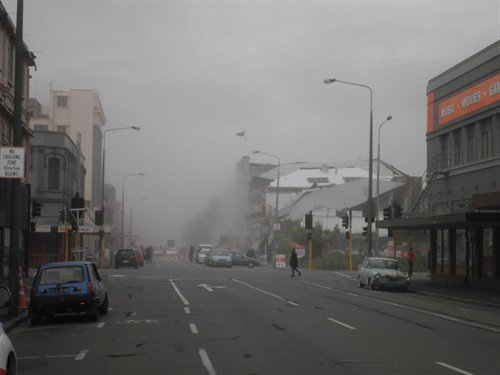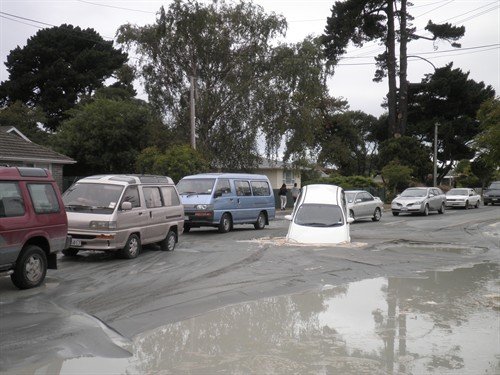Documenting the earthquakes
A new addition to our Community Collection is a collection of photographs and videos by Mark Lincoln. Mark was working in the CBD when the earthquake struck on 22 February 2011, and began taking photos as he left his office.
He comments on this photograph, "That first photo was my first view after coming out of the office. There's a popular wide panoramic photo that someone took from the Port Hills of all of the dust rising up from the city - [my photo] shows what it looked like from within the dust cloud! There are people gathering further down the street where a building has collapsed."
Mark continued to take photographs as he slowly made his way home, documenting the confusion and terror in the central city, the fallen buildings, the traffic congestion and the extensive liquefaction in the eastern suburbs. He says, "The most common sight was extensive damage to the roads. Papanui, Breezes, Wainoni, Shortland Street and many more roads had large cracks and large sink holes. There were approximately 6 cars and 1 large Ready Mix cement truck that had fallen into holes within a few blocks of each other. All people appear to have escaped without serious injury as far as I could tell."
Once power was restored to his home, he began following the #eqnz tag on Twitter, and realised a lot of people from outside Canterbury were desperate for information. "As I had a blog (at www.nzraw.co.nz) and a camera, I figured I'd help broadcast some images and stories to those who were searching for information online. At the time, international news channels were broadcasting the absolute worst of the damage and suffering and my family and friends back in the UK were pretty frantic with worry, pretty much believing that we were living in a pile of rubble. One of my early videos was actually just to show them that our house was still standing and we were alive and well!" Mark says he was lucky, because despite working in the CBD and living in one of the worst-hit suburbs he and his wife were unhurt, and their house suffered very little damage.
As well as his photographs and videos, Mark has donated PDF copies of some of his earthquake blog posts to the UC QuakeStudies archive. Sitting alongside the photos and videos, the blog posts provide a valuable context to the images, making the collection a very interesting one to both researchers and to the general public. Mark says, "My photos have now appeared in studies around the world as well as TV documentaries including a production by National Geographic. I was very honoured when the University of Canterbury contacted me to add my collection to their archive to benefit others. All quite humbling and all simply because I was in the wrong place at the right time!"
Mark's collection showcases the important role that members of the community have had in documenting the earthquakes. Bloggers and amateur photographers were able to respond to the earthquakes immediately, documenting the experiences of Cantabrians from the moment the earthquakes happened, and through into the recovery phase. Collections like this one help build a picture of the earthquakes through the eyes of ordinary people, offering a wider variety of perspectives than traditional media alone. In this way, Mark Lincoln's collection will prove a fantastic asset for future research.

Photographs by Mark Lincoln, licensed
under a Creative
Commons Attribution-NonCommercial-NoDerivs 3.0 New Zealand
License


